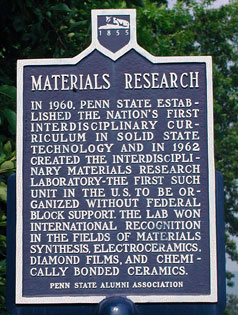The Penn State MRSEC was established in 2000 as a single Interdisciplinary Research Group (IRG), the Center for Collective Phenomena in Restricted Geometries (DMR 0080019). In 2002, this IRG merged with a new MRSEC, the Center for Molecular Nanofabrication and Devices (DMR 0213623), which was comprised of two IRGs: Chemically Advanced Nano-lithography (IRG1) and Nanoscale Motors (IRG2). The administrative and outreach activities of the two Centers were combined, and the MRSEC was renamed the Center for Nanoscale Science. In 2004-05, the original IRG phased out its effort in fluids and polymers and split into IRG3 (Electrons in Confined Geometries) and IRG4 (Electromagnetically Coupled Nano-structures). In 2007, a new IRG on Strain Enabled Multiferroics, which grew from a seed project, was added. In 2008, the Center was competitively renewed as a four-IRG MRSEC (DMR 0820404), in which Chemically Advanced Nanolithography phased out and Strain Enabled Multiferroics became the new IRG1. In 2014, the Center was again competitively reviewed as a four-IRG MRSEC (DMR-1420620). In this process, the IRGs on Charge and Spin Transport in Quasi-1D Nanowires and Electromagnetically Coupled Nanostructures were phased out, and two new IRGs that had their roots in seed projects were formed. In 2020, the Center was again competitively reviewed as a two-IRG MRSEC (DMR-2011839).
Current IRGs include:
The MRSEC builds on a long history of excellence in materials research at Penn State. Penn State was the birthplace of the Materials Research Society. Its Materials Research Laboratory was established 50 years ago and provided the scientific foundation for the Materials Research Institute (MRI). MRI now supports the interdisciplinary activities of over 200 research groups at Penn State. The Penn State MRSEC draws competitively from this wide pool of talent and diverse expertise. It also serves as an organizational hub for educational and outreach activities in materials at Penn State. New discoveries in IRG and seed projects propel the scientific evolution of the MRSEC.



